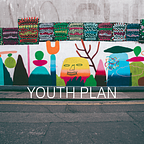Hacking the campus, part I
What would a greener, more accessible, funnier, safer, aesthetically more appealing university look like after the health emergency is over — and we all meet again on campus?
This is a question the project “Planning with Youth” asked a group of over 50 students enrolled at the IT, Media and Design program at Södertörn University in Stockholm.
On a winter day in the end of the challenging year of 2020, we met virtually (as so often these days) with the students. We engaged them on a creative activity seeking to envision changes they would like to see at our university campus. Paper crafting was used to give form to their ideas.
With us from Italy was the paper artist and project collaborator Annalisa Metus. Annalisa introduced her work and gave some tips on how to work with paper and cardboard to visualize needs for urban environments.
The scenario
The scenario that was given to the students was as follows.
“We live in a time where a worldwide pandemic has changed our everyday lives and how we socialize and move in society. We are encouraged to physically distance ourselves and work and study away from home to minimize the risk of spreading the virus.
In the wake of COVID-19, many things have changed and will continue to change, such as how we design our cities and how and where we meet and interact. There will come a time when we return to a different everyday life: different from the situation we are in as of this day, with a third wave hitting Swedish communities — yet also different to the world we knew before the pandemic.
We need to rethink our urban environments to better fit a society in change. We need to merge physical planning with social values and needs, so that urban space can be places where we find joy and peace in both challenging and prosperous times.
There will come a day when we gather again on the university campuses across the world. For the authors of this text, this means the Södertörn University campus. In this return, it is vital to consider both the natural environment that exists within the campus area, and the physical environments created by humans — and how to merge these to a stimulating, healthy and inclusive campus environment. When we return, we want to return to a campus environment that is greener, safer, more fun and aesthetically more appealing — a sustainable place for the future”.
The challenge
The students were asked to critically look at the current campus infrastructure and then think about what they would like to change to make it a more sustainable place. They were asked to use paper and cardboard to give shape to their ideas.
Curious to see the results?
This post is the first out of three where we show the visual stories of the students, and how they hacked the Södertörn University campus. Follow us for more here on Medium.
This activity is part of Working Package 3 where we test different participatory tools and methods with young people and assess how these allow youth to express their needs and preferences about public spaces. A more in-depth understanding of their needs is an important matter.
How much youth socializes and engages with green areas and public places dramatically impacts on their well-being and health. Research has found that young people in Sweden spend less time outdoors and there is an urgent need to understand how public places and urban nature can better fit their needs.
From a policy perspective, there is agreement that the voices of children and youth need to be heard. Important steps have been made, starting with The United Nations Convention on the Rights of the Child, and continuing with Sweden now making children’s rights to be included in spatial planning a requirement by law. On the other hand, the field lacks methods and tools which could best support planners and practitioners on this task. Public hearings, open consultations, and other similar expert-driven and expertise-centered events are not suited for the purpose.
There is a need to innovate on the methods, but also to develop a more in-depth understanding of the needs and values of the younger age groups in a long-term perspective.
In this project, we test and explore a diversity of engagement methods. We study ways how to expand the space and the audience for youth in urban planning. We acknowledge the need to start from their preferences and not simply waiting for youth to show up at public events which so much mirror the values and codes of conduct that regulate the world of (expert) adults.
This text was written by Emma Blomquist, Sofia Lundmark and Romina Rodela.
